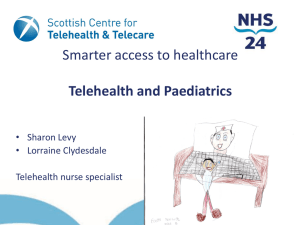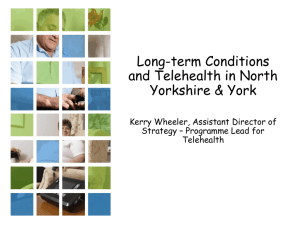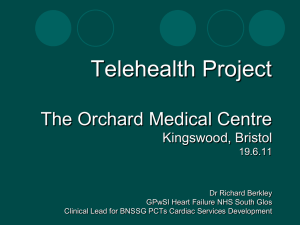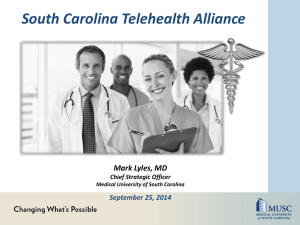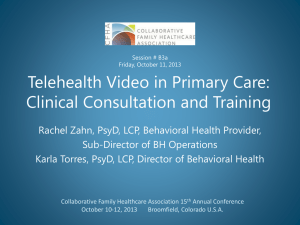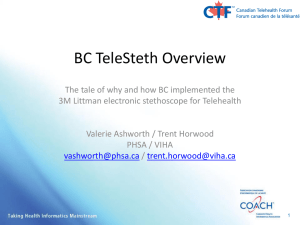Telehealth workshop
advertisement
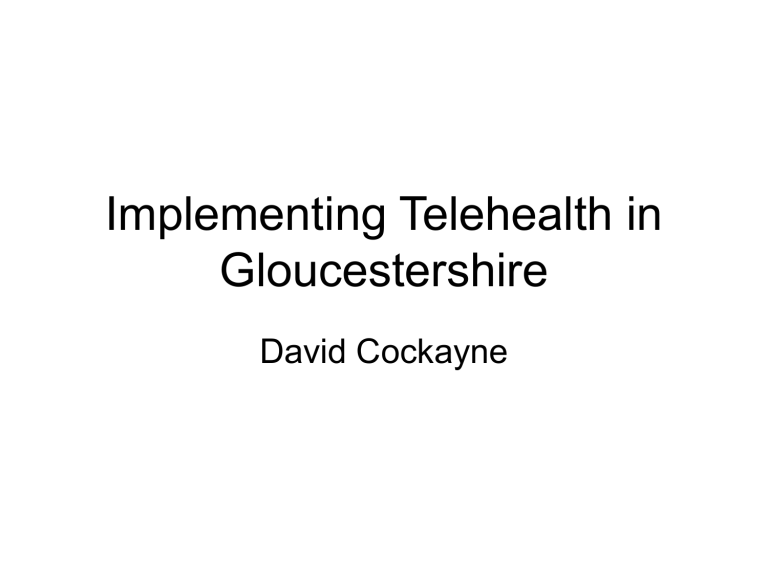
Implementing Telehealth in Gloucestershire David Cockayne What does a mainstream telehealth service look like & what will Providers be expected to do? Clinical Intervention: Phone consultation, self care advice, home visits, practice appointment, review patient parameters etc Perceived activity scheduled into PN calendar, usually 1 to 2 - 10 min tel triage appointments Patient identified & referred for Telehealth service (20 units per practice) (2.6 units per GP) Service desk: patient enrolled onto TH Service desk: installation visit scheduled Patient/carer trained and equipment installed & tested by on-site visit Additional support provided Practices have implemented layered to help provider units: COPD, HF, & Diabetes care pathways clinical triage to support TH : First review = Practice Nurse Suggesting appropriate TH referral points If further support needed review with Risk stratification GP or Spec/Com Nurse List of SUS Data activity Clinical advocates Practice/clinical activity Clinical escalation rate ranges 2 to 4%. Batch update at Practice relevant time i.e. 11am to Technical triage2pm. = non clinical validation of alert (based on 4% = <1 ALL incoming per daydata per to practice) prevent inappropriate alerts being escalated. Contact patient/carer, arrange installation Generally only validated red alerts are escalated to Co-ordinate equipment inventory clinicians Co-ordinate home assessment Co-ordinate letter to GP, Consultant etc Single point of contact Referral management Installation Ongoing Service Support Review & De-registration Information Reporting Service desk activity Clinical assessment of validated data Escalate validated high alerts to Practice Technical triage validation of all data Patient data accessed via web-based triage software hosted on N3 Telehealth is not an emergency response system Collect written Usually once to twice a day readingsIdentifiable , often just Mon to Fri Anonymised data data Daily dataconsent collection: Ensure end to end transmission (patients may do 7 days a week) transmitted via hosted in N3vital signs & health Health & Safety procedure ensured Recent NYY 200 patient satisfaction survey secure telephony environment question responses Answer any patient queries (non clinical) 96% satisfaction Mainstream telehealth overview – NHS Glos • NHS Glos procured a fully managed telehealth service for 2000 concurrent patients based on a lease deal. Includes provision of an full time implementation team to support the implementation, clinical engagement and deployment of the 2000 patient systems • Telehealth forms an integral part of the PCT’s QIPP programme to deliver financial savings in current financial year. • Originally telehealth service was implemented within primary care, primarily within COPD and CHF pathways, with Diabetes and CHD pathways as co-morbidities. • Now focussing on a wider scope due to improved reporting system and support for clinical innovation • Strategy was to initially engage health care providers through care pathway optimization and then implement across all 6 localities in a phased approach of 3 stages, 2 localities at a time. Mainstream telehealth overview 2 • Primary care engagement commenced Aug 2011 (Nov 2011 deployment) and focussed on each locality for 6 weeks. Localities selected on weighted criteria (see next slides) • Although primarily focussed on managing patients through primary care, whole health economy approach for engagement including OOH, acute, community, mental health and social care (telecare) services • NHS Glos has an established small scale service for telehealth based within spec nursing service (COPD & HF – 200 patient systems - initially Tunstall supported). Managed separately from mainstream programme but step up & step down process between specialist services and primary care • Community Services (DN service) CQUIN target for recommendations for referrals into PC Prioritising the localities – overall scoring After applying the criteria, the localities have been scored and prioritised as follows: Locality Disease prevalence (criteria 1) Finance/ activity (criteria 2) History of joint working (criteria 3) Clinical buy-in (criteria 4) Gloucester City 5.0 5.0 6.0 6.0 22.0 1 Forest of Dean 3.0 2.5 6.0 6.0 17.5 2 Cheltenham 5.0 5.0 3.0 4.5 17.5 3 Stroud 3.4 3.8 4.5 4.5 16.2 4 Tewkesbury 1.6 1.0 4.5 4.5 11.6 5 Cotswolds 2.4 2.8 3.0 3.0 11.2 6 Total score Priority Notes: 1. Criteria 3 and 4 are weighted at 1.5 to reflect the need for clinical engagement to roll out the telehealth equipment 2. Fof D given priority as number 2 as it has higher clinical engagement score than Cheltenham. It also enables an urban and rural implementation to commence at the same time. 5 Engagement Schedule July 06 August 13 20 27 04 11 September 18 25 01 08 15 October 22 29 05 12 November 19 26 03 10 17 Phase 3 Pathways ► Stakeholder Engagement ► Workshops ► New pathway confirmation Engagement Confirmation Implementation ► Phase 1 ► Phase 2 ► Phase 3 Phase 1 Phase 2 Phase 3 Workshop – 2 a week Pre-meet with locality PBC leads before start of phased implementation Note: After October a targeted implementation will be carried out depending on the results of the fist 5 months. 6 24 How the managed service is implemented in Primary Care within NHS Glos Progress so far • Care pathways reviewed/optimised and telehealth embedded within care pathways. Optimised pathways placed on MoM • All 6 localities are now engaged (see next slide). Practices engaged are now beginning to refer and manage patients. • Primary care incentive agreed for QP QOF (9,10,11) and additional short term (12 months) LES payment for initial workload of having staff trained and activity associated with consenting patients (per patient LES payment). 81 out of the 85 GP practices have now signed up for the QOF payment through TH. 550 TH service users – 350 – GP • Approved incentives for care services (CQUIN) for referrals to primary care and number of staff trained. Supported care services in tools to support patient referrals – assessment template • Developing clinical advocates for peer to peer support – sharing best practice • Working closely with early adopters to ensure managed service is working seamlessly and efficiently for each practice Next steps • Continue with primary care engagement and support practices on the practicalities of implementing TH. Key focus is: – Increase number of practices referring and managing patients (realising the 81 signed up practices (65 ish referring) – Supporting patient selection and capitalising on the number of patients each practice refers (e.g. patient centred objectives for management - see slide) – Establishing practice processes and managing and reviewing alert escalations – Developing clinical advocates for peer to peer support • Continue to support whole health economy engagement ensuring TH processes are embedded within relevant services Example implementation summary Tewksbur Cheltenha y Cotswolds m Stroud Glouceste r FoD COUNTY Held Scheduled Introductory meeting TBC 76 Training meeting 6 36 21 Introductory meeting 28 10 Training meeting 0 7 2 Introductory meeting 1 2 18 Training meeting 8 0 1 3 Introductory meeting 8 19 Training meeting 1 0 10 6 Introductory meeting 4 14 Training meeting 3 7 6 Introductory meeting 0 4 11 Training meeting 0 2 4 4 0 1 Training meeting 4 0 1 80% 90% 10% 0 9 Introductory meeting 0% 3 20% 30% 40% 50% 60% 70% 100% Example patient objectives for managing on Telehealth Highlighting examples of where telehealth has been found to be helpful, backed up by peer to peer endorsement and patient examples has proved effective, e.g. • Stable but significant illness – use as a tool to reinforce self management and observation – Trend monitoring for example weight in heart failure patient – Symptom monitoring for example change in sputum colour and volume • Extra vigilance during a period of medication titration – Bblocker titration in heart failure checking heart rate – Monitoring of hypotension in Ace inhibitor up-titration • Alerts to identify episodes of decompensation early – Oxygen sats dropping in patient with COPD – Significant unusual weight gain in heart failure patient Key considerations when implementing telehealth Communications are key – especially in early stages of engagement Experience has shown that it is important to communicate clear messages on: • Why TH has been purchased • What the desired outcomes from implementing telehealth are • Time frame for deployment & how it will be resourced/supported In Glos this has been based on: • • • • A need to reduce local health care costs especially around NE activity and to do so quickly. Growing prevalence's of LTC and an aging population Need to manage things differently with the same size or a reduced workforce Evidence for effectiveness of TH to empower patients to self care and support remote management of patients in their own home while reducing NE activity – Other key issues: • • • • Engage key/influencing clinicians in procurement How Telehealth will benefit each clinical group (GP, Specialist, Community Nurse etc) Any incentives to adopt TH into their normal clinical practices? E.g. QP QOF, LES, CQUIN etc What processes/services are in place to support the implementation of TH and minimise the impact on their already busy workloads. 12 • How the service will be evaluated • TH is here to stay – not just another short term initiative! Key considerations – Practical Once we get patients onto Telehealth, keep gathering momentum: • Intensively work with early adopters to ensure TH service is running as smooth as possible and all clinical escalations are appropriate – referral initiatives • Build hearts and minds – Look to develop local clinical advocates – Capture any early good news stories and patient champions etc • Provide timely updates on service progress (see next slide)
